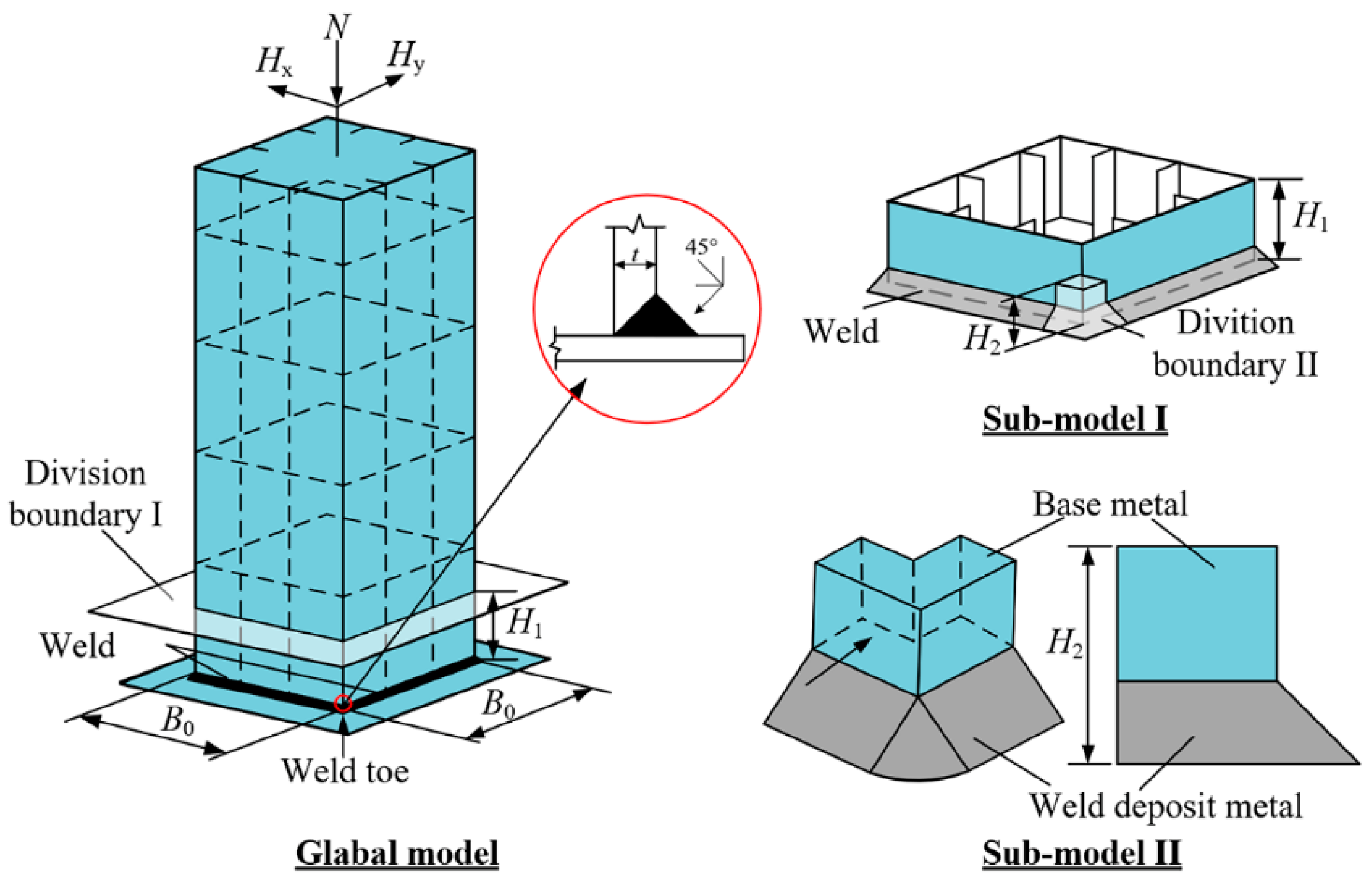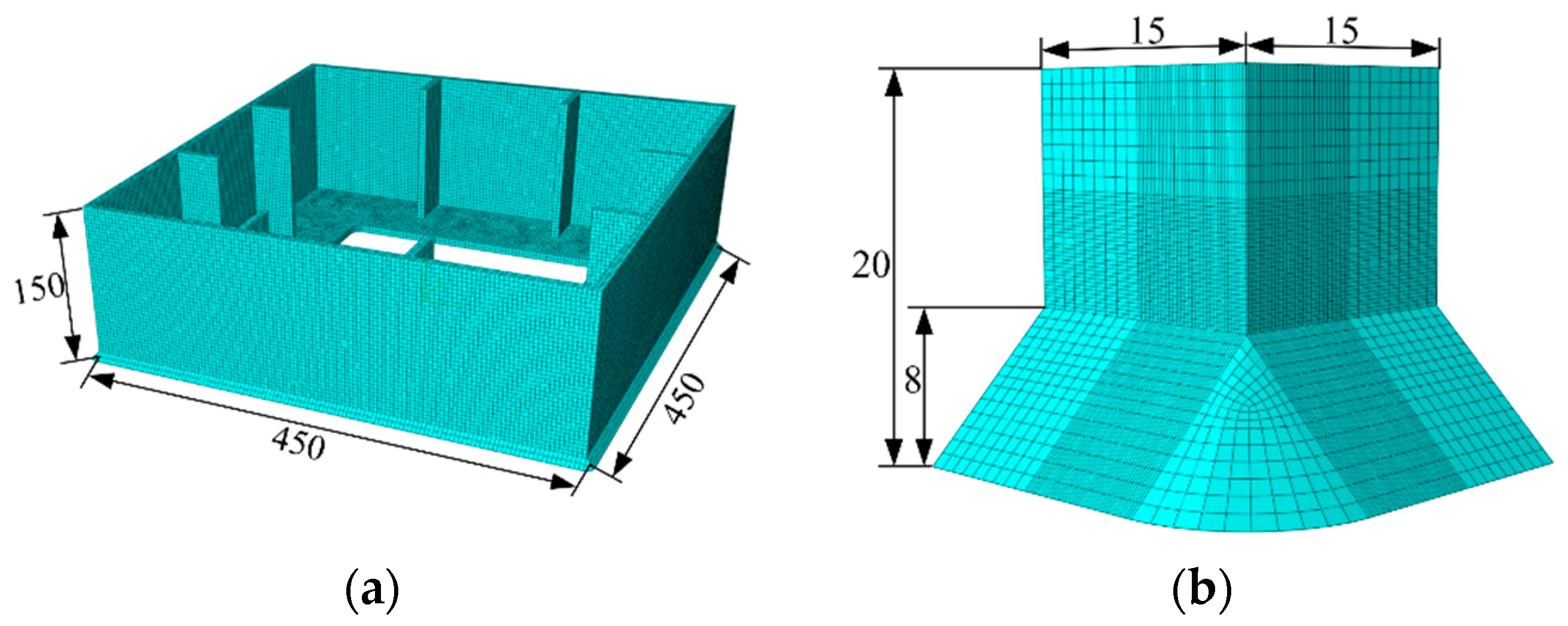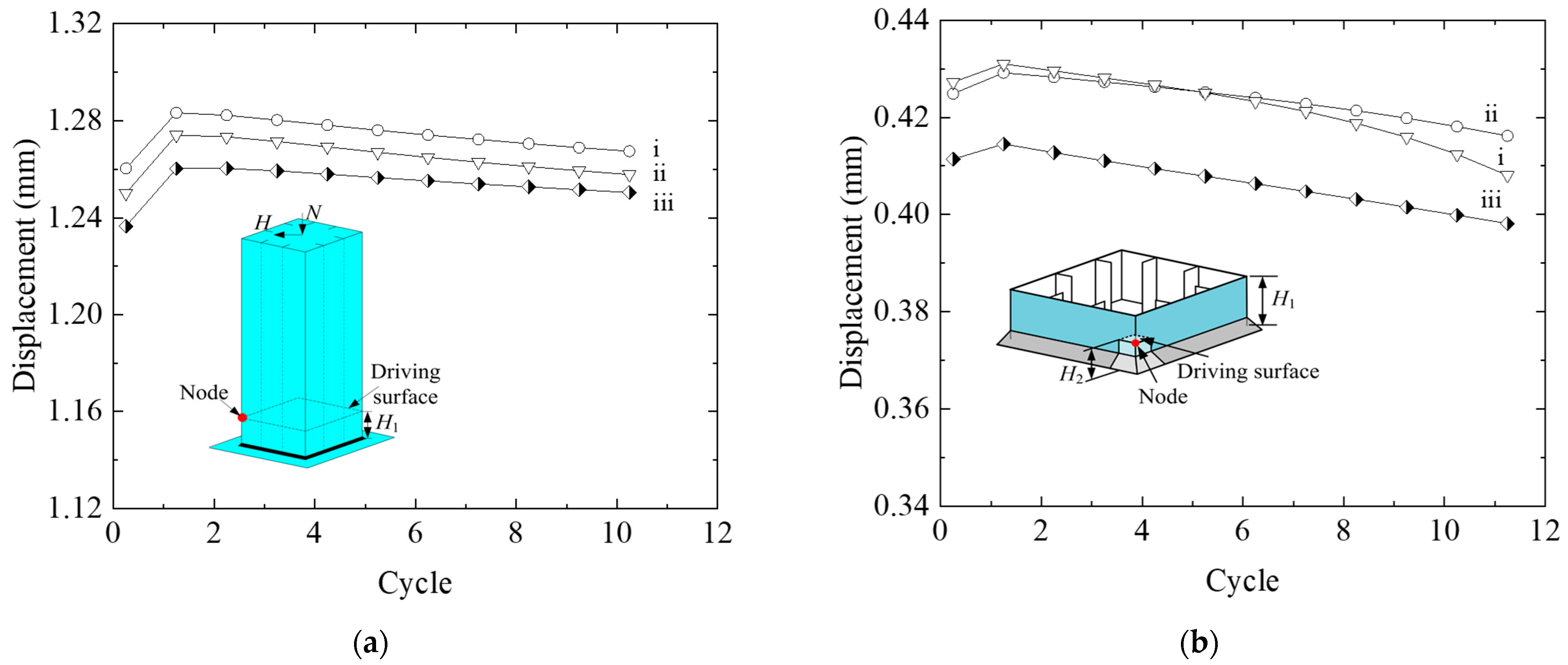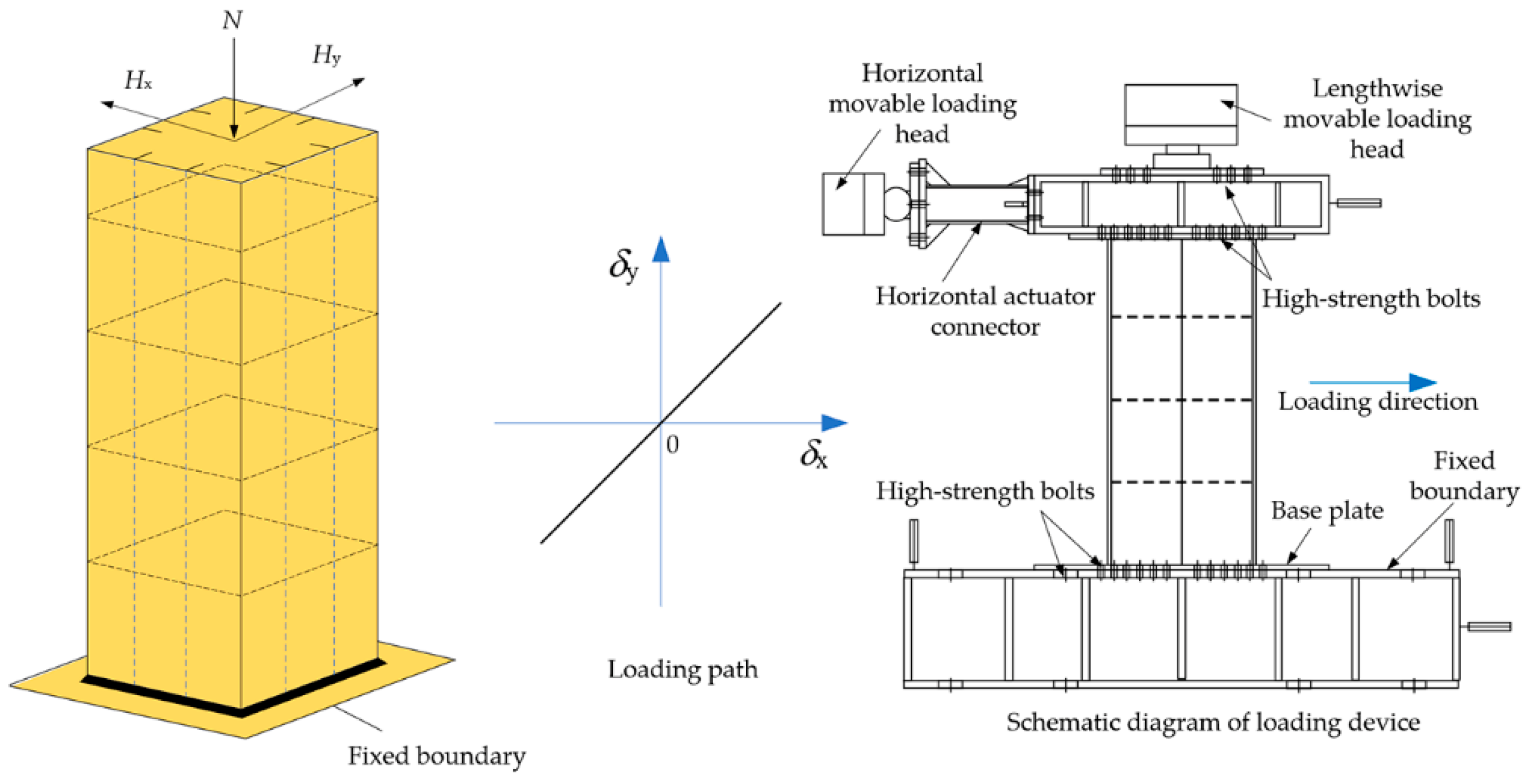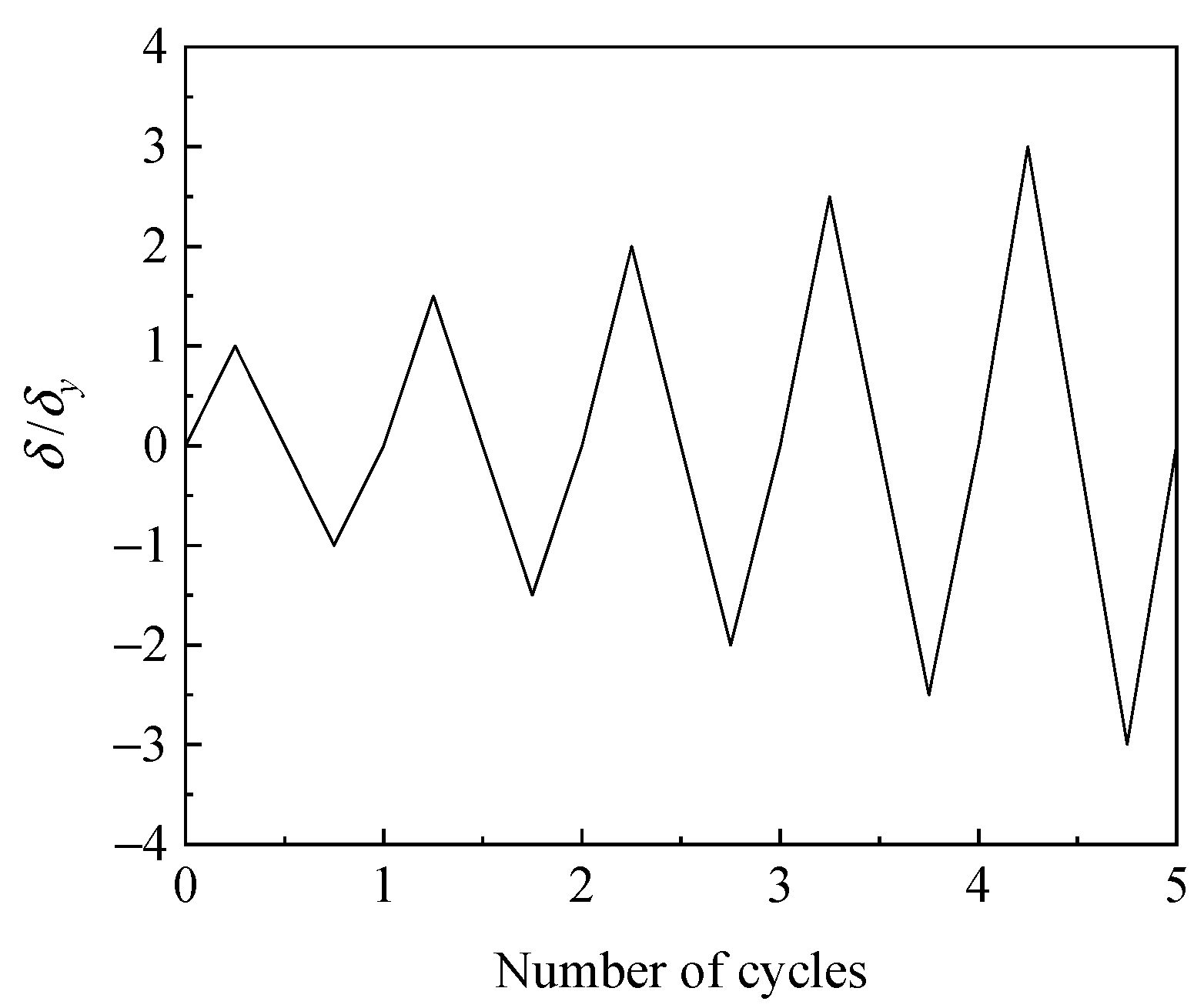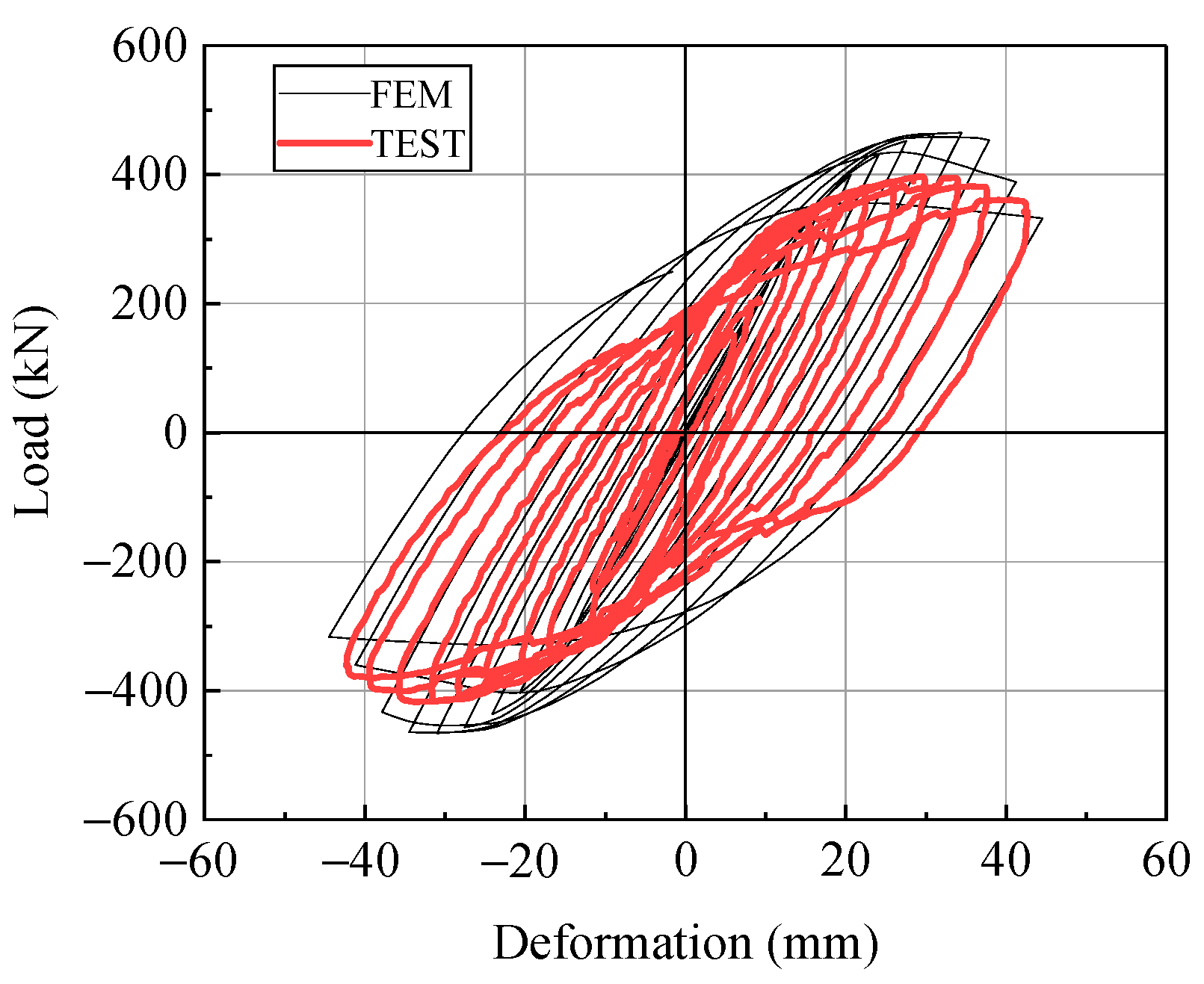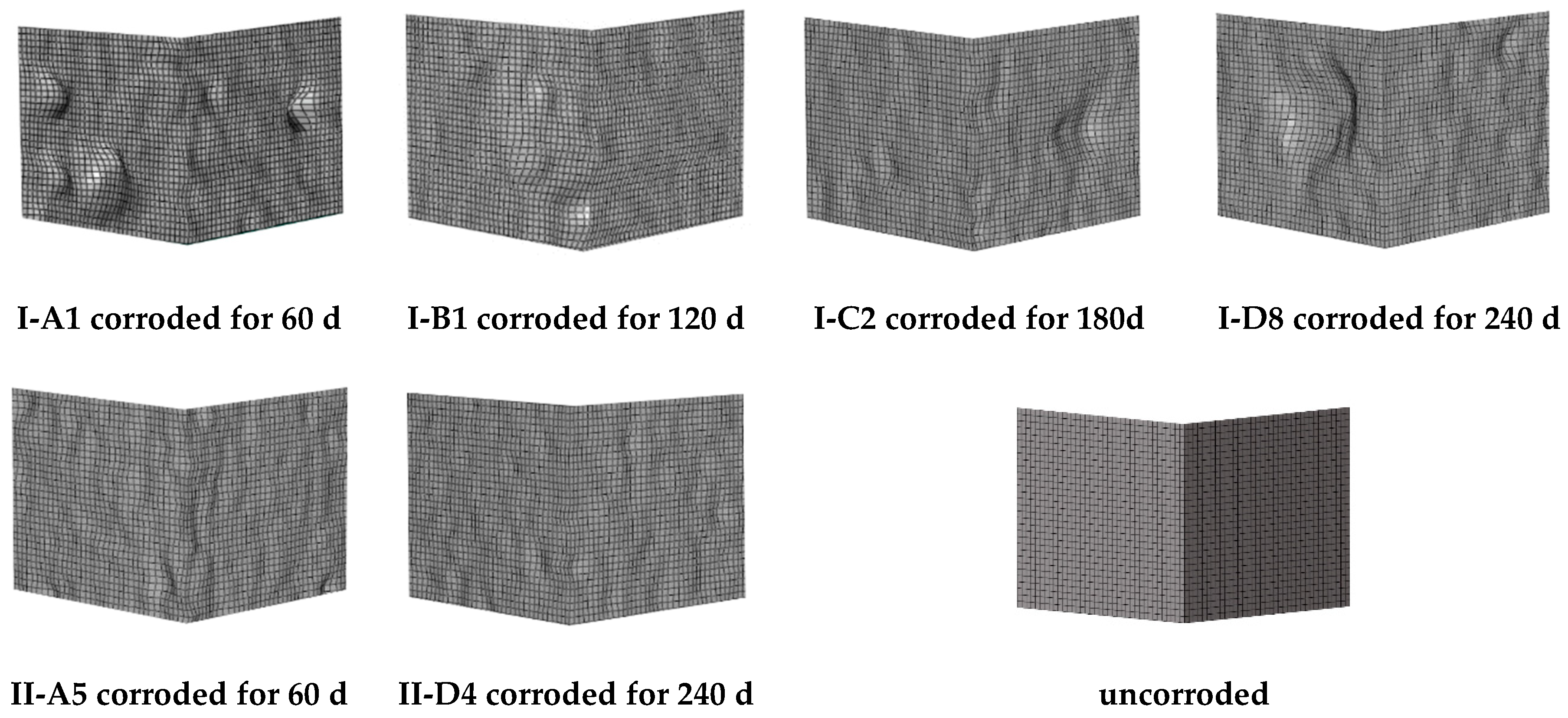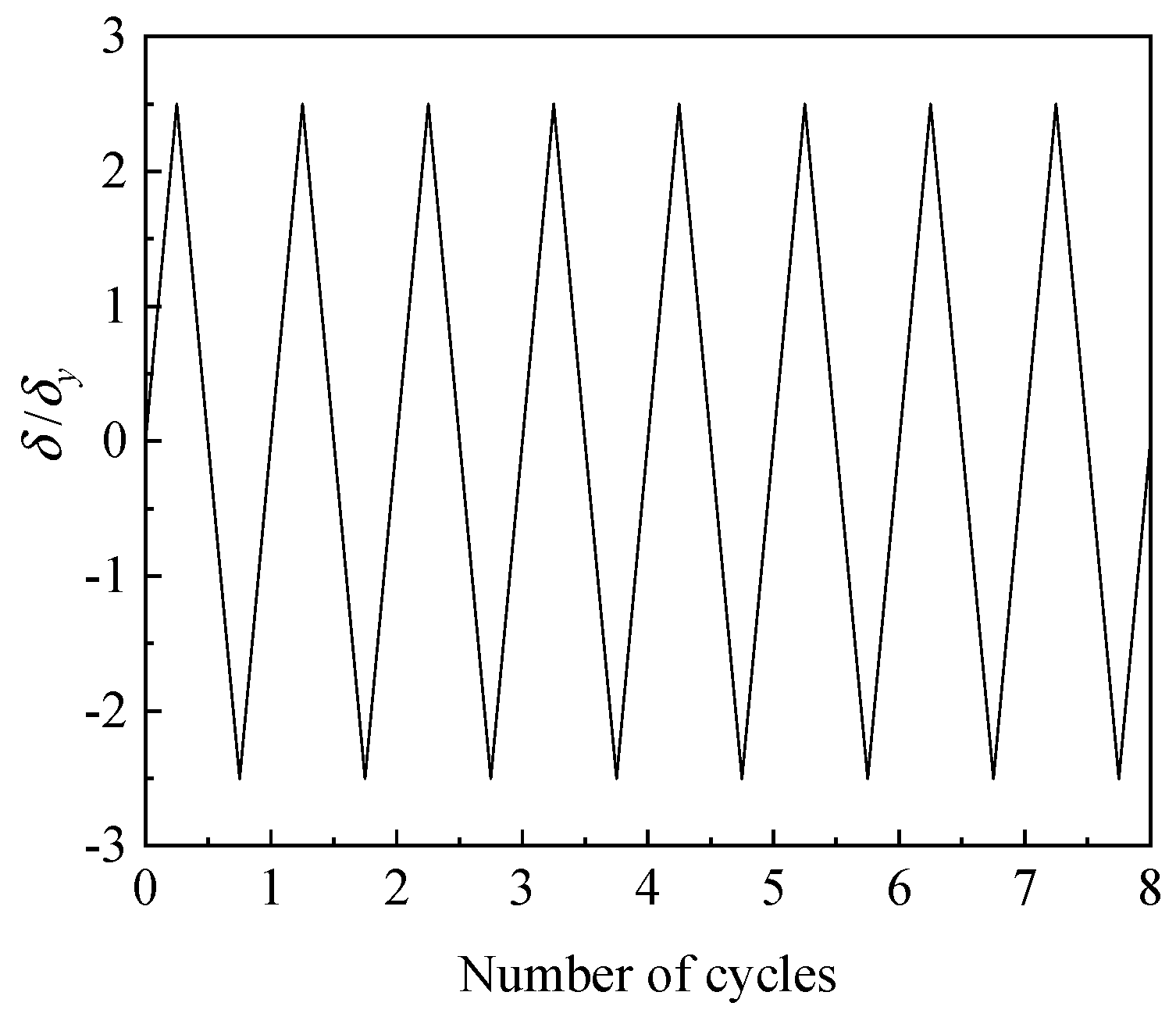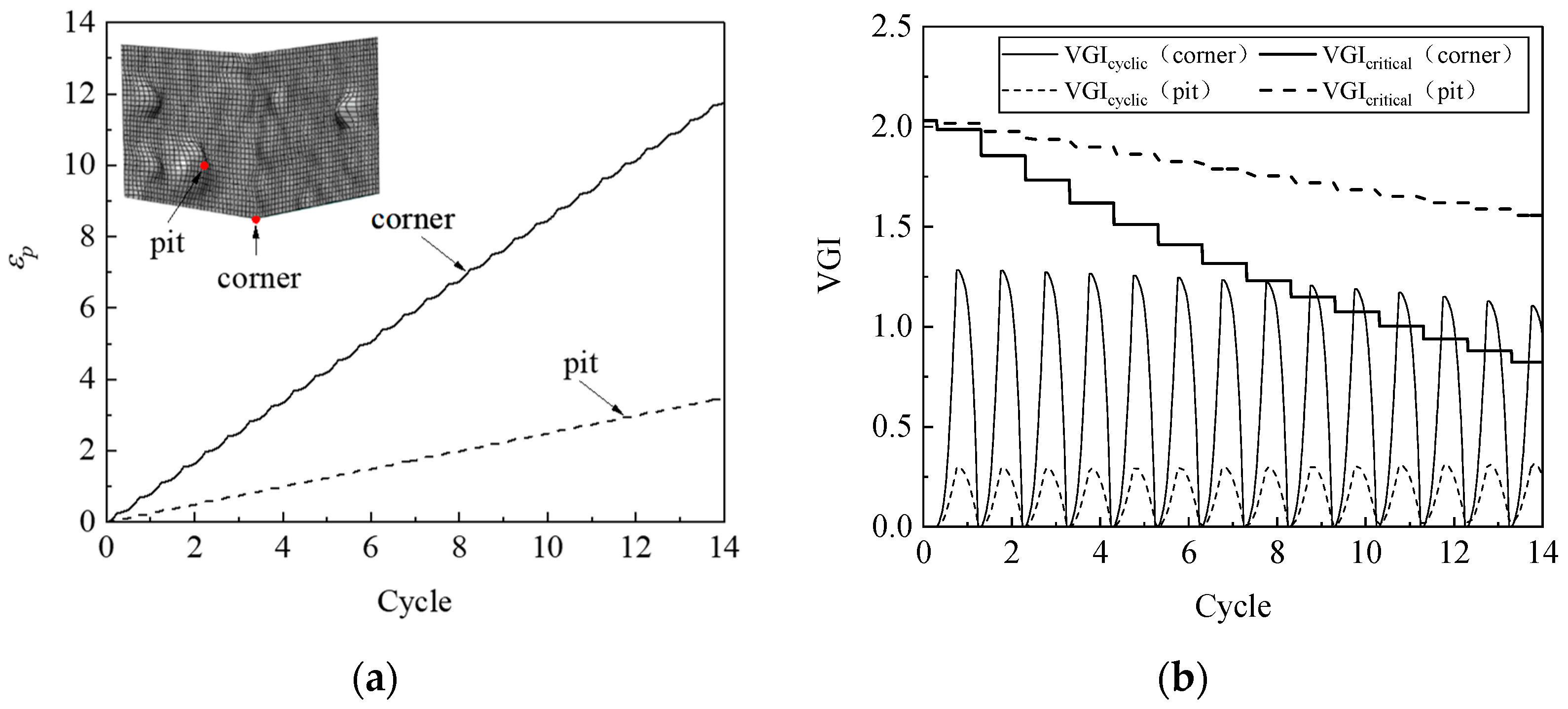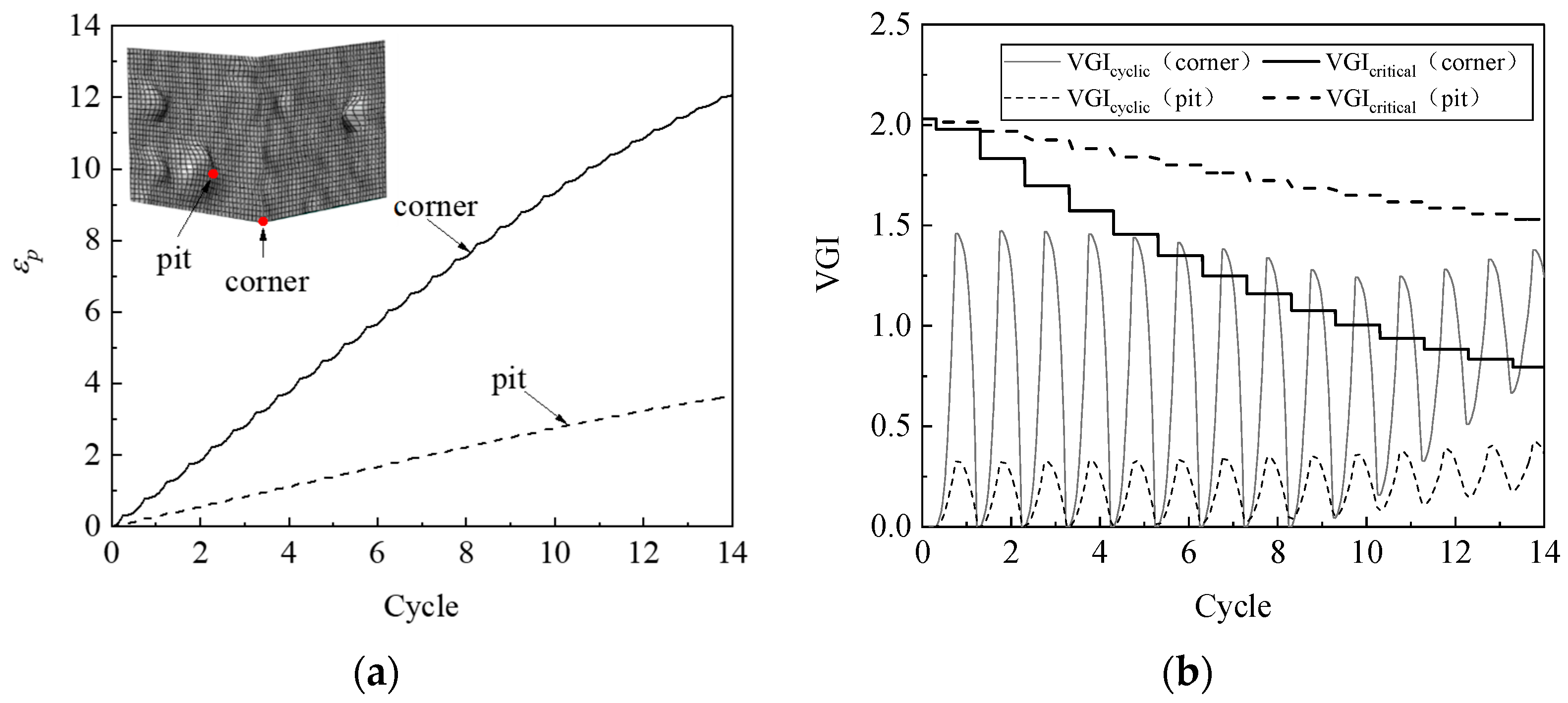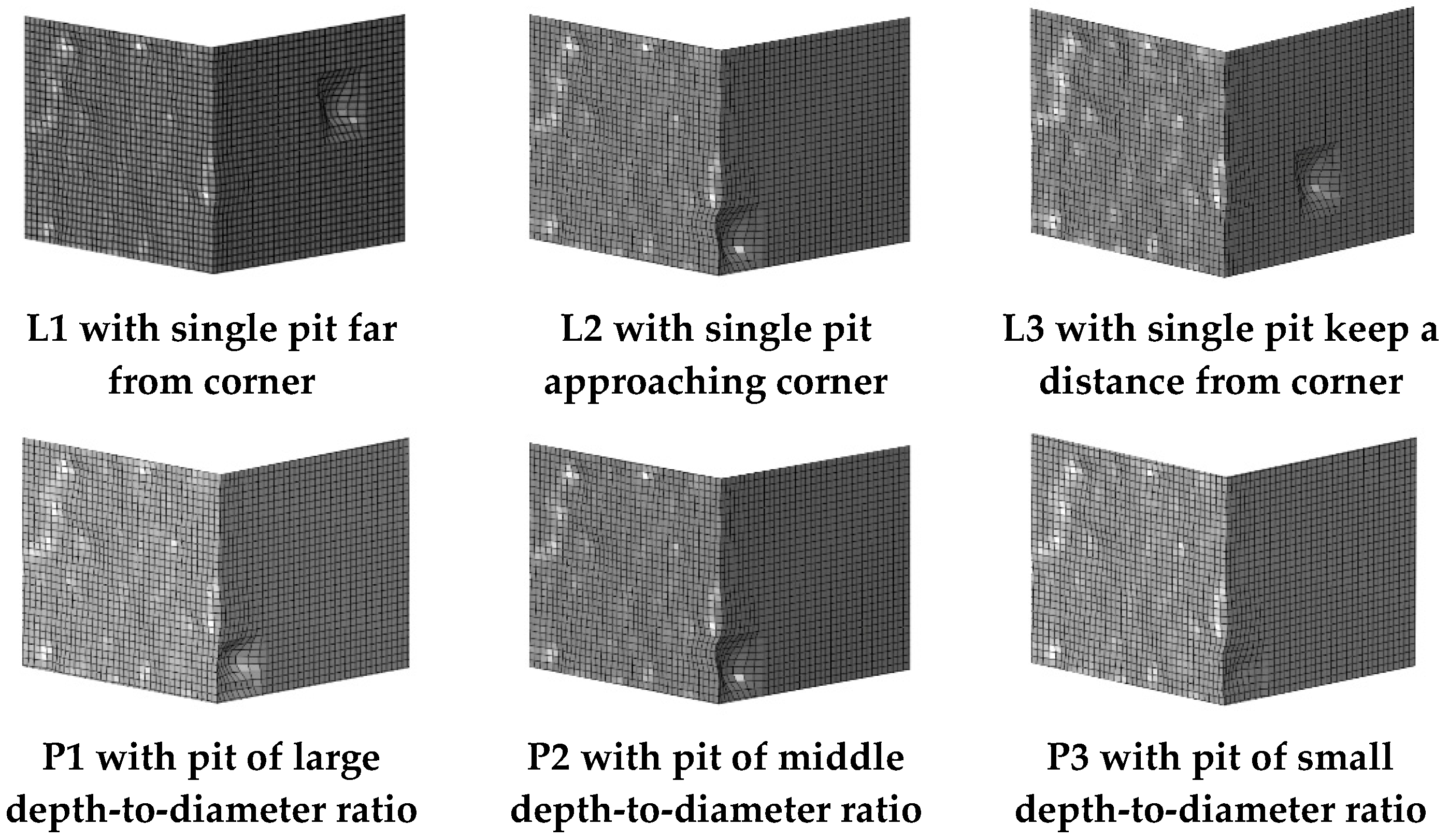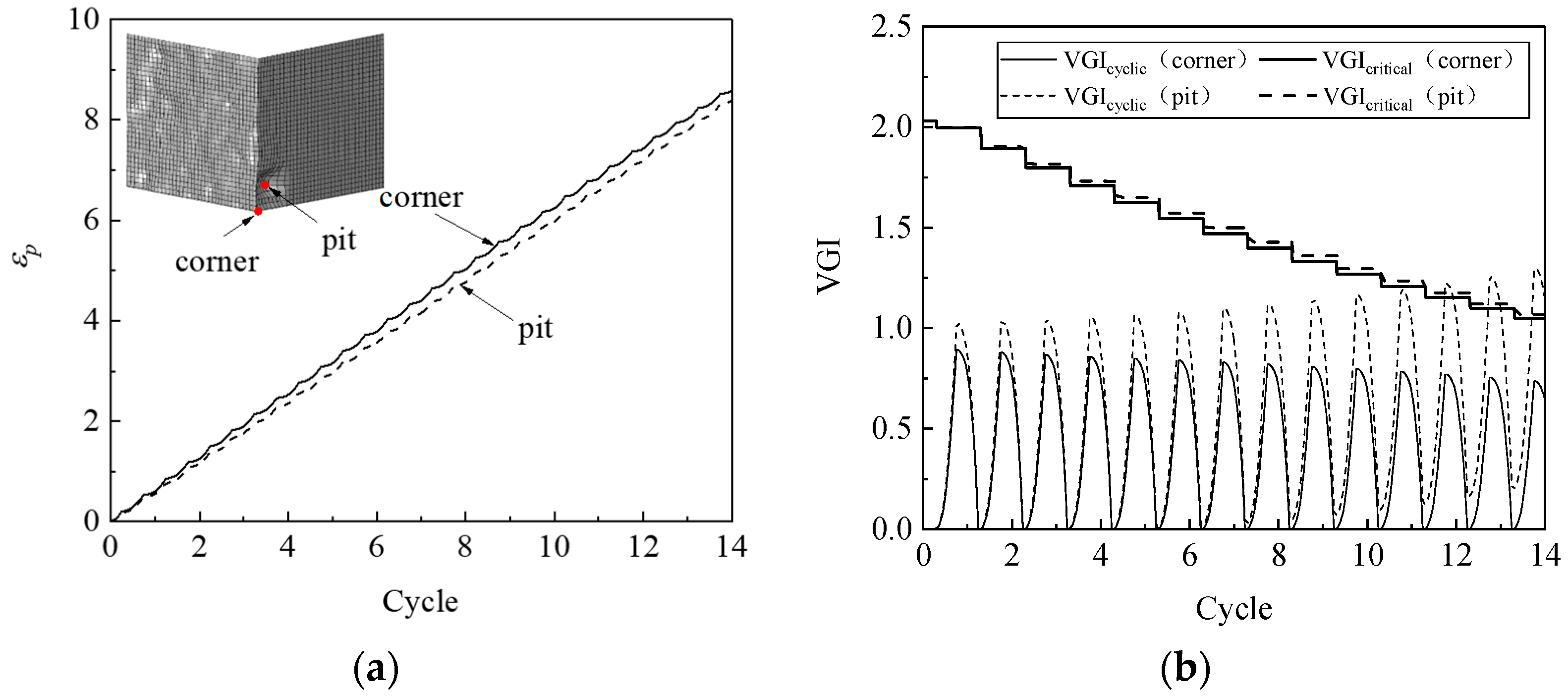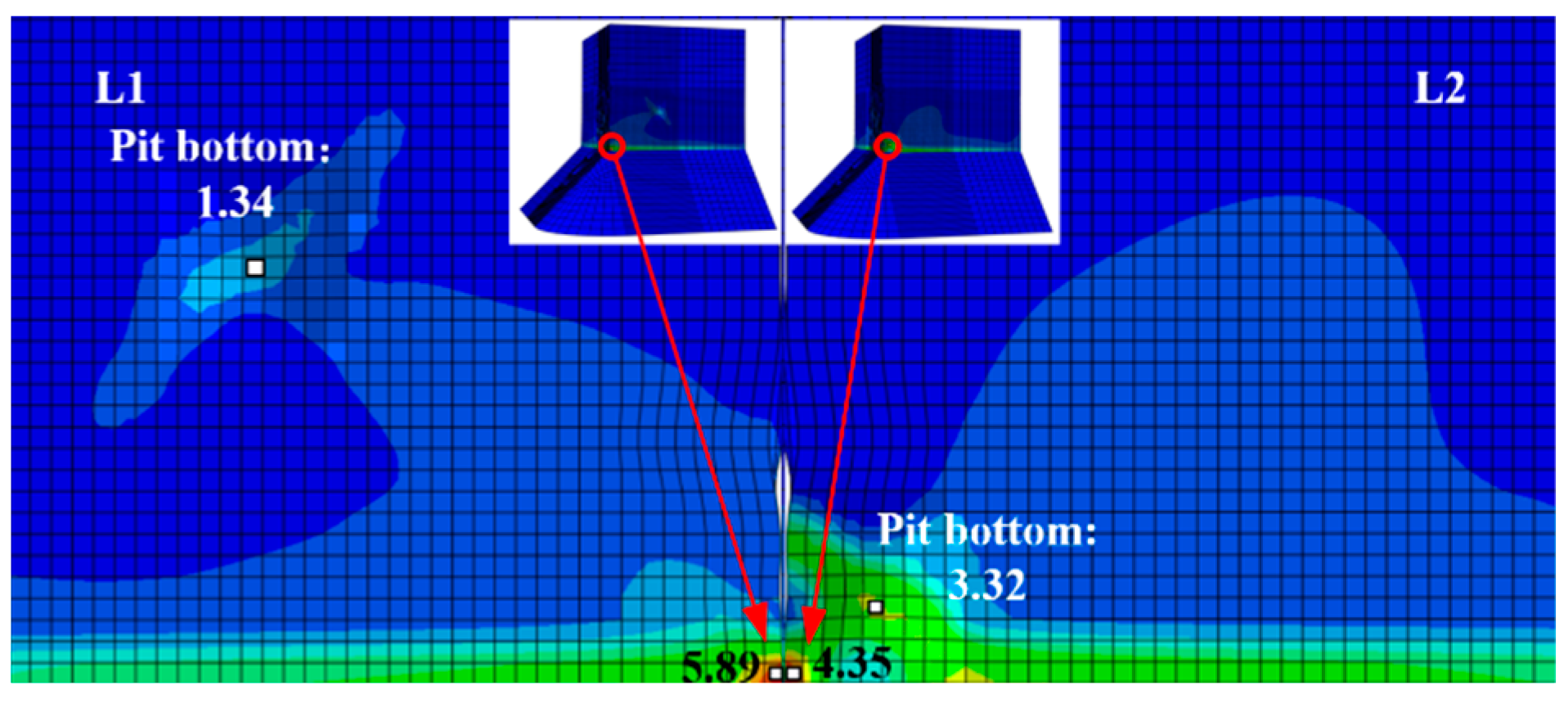2.1. Structural Parameters
To investigate how corrosion morphology affects the ULCF resistance of corroded steel piers, we use a single-column steel bridge pier as research object (see
Figure 1).
Table 1 lists the geometric dimensions of the steel pier. The pier is made of Q345qC steel, which is widely used in bridge structures, and its constitutive relation is based on the Lemaitre–Chaboche [
28] hybrid hardening model. The size of the yield surface σ
0 can be expressed with a simple exponential law as
where σ|
0 is the yield surface size at zero plastic strain,
Q∞ is the maximum change value of yield surface, and
b is the changing rate of the yield surface as plastic strain develops.
Q∞ and
b are additional material parameters that can be calibrated from cyclic test data.
The overall backstress
α is composed of multiple backstress components
αk, where the evolution of the backstress components
αk of the model is defined as
where
Ckin,k is the initial values of the kinematic hardening modules, and
γk is the reduction rate of
Ckin,k with increasing plastic strain. Overall backstress
α is calculated from the relation
The relevant cyclic hardening parameters of Q345qC steel are given in
Table 2 [
29,
30], where
k = 3, and the material parameters were calibrated by Wang [
29] and Liao [
30] from cyclic test data. Given that ULCF crack-initiation life strongly affects the welding properties, the materials of the steel pier are divided into two types of metals: A base metal and weld-deposit metal.
2.2. Corrosion Morphology Simulated Finite Element Model
Coating degradation, small gaps introduced at joints, etc., can induce an electrochemical reaction between the steel and surrounding medium to corrode the structure. The corrosion of the steel plate can be divided into uniform and pitting corrosion. The former usually decreases the thickness of the steel plate, and the latter often pits the surface of the steel plate.
Experiments have been performed to show that corrosion pits serve as the initiation points for fatigue cracks and shorten the ULCF crack-initiation life [
27]. Therefore, the surface morphology of the corroded steel (e.g., the size and distribution of pits) significantly affects ULCF crack initiation and propagation.
Figure 2 compares the surface morphologies of specimens corroded under different times. A shorter corrosion time results in fewer pits on the surface of the specimen; hence, the pits consequently being less dense on the surface. As corrosion time increases, the pits become more densely packed on the surface; some pit communities are formed in which pits overlap. While the corroded area increases over time, the aspect ratio of the pits on the steel surface remains essentially the same [
31].
To investigate how the corrosion morphology affects the ULCF performance of square steel piers, a precise simulation of the pitting morphology of the steel surface is warranted.
The FEM based on the CVGM was established to numerically calculate the ULCF crack-initiation life. A submodel was implemented in ABAQUS to improve the calculation accuracy of ULCF fractures while limiting the number of elements in FEM.
As shown in
Figure 3, two refined pier submodels were established to describe the stress distribution in the corner of a square and thin-walled pier as the ULCF crack initiates in the weld toe under seismic loading in two horizontal directions. The FEM comprises a global model, submodel I, and submodel II. Submodel I is a part of the global model and extends from the base of the pillar up to a height of 0.15 m (
H1 = 0.15 m, see
Figure 3). Submodel II is a part of submodel I and covers the weld toe in the corner, which is predicted to be a critical position under the ULCF load. In particular, submodel II extends from the base up to a height of 0.02 m (
H2 = 0.02 m, see
Figure 3). The global model uses four-node iso-parametric shell elements (S4R) and beam elements (B31). Along the thickness direction, the shell elements have five integration points and the element dimension is approximately 30 mm. Submodel I uses eight-node hexahedral elements (C3D8R), approximately 3.5 mm in size, and submodel II uses solid C3D8R elements as well.
Table 3 lists the meshing information and
Figure 4 shows the mesh units and submodels. Note that the minimum element size of submodel II is approximately 0.2 mm based on the characteristic length parameter of the steel material. A mean (or expected) characteristic length of 0.2 mm was determined for mild A579 Grade 50 steel as the average size of the plateaus and valleys based on 15 measurements from micrographs [
32]. Furthermore, Liao et al. [
33] calibrated the characteristic length of Q345 steel in China through tensile and cyclic load tests, and proposed the mean value of the parameter is around 0.2 mm. while another Liao [
30] found the mean value of characteristic length is from 0.21 mm to 0.29 mm. Therefore, the minimum size of submodel II defined by 0.2 mm is sufficient in consideration of characteristic length.
In order to examine the mesh dependency of global model and submodel I, numerical analysis on model convergence and influence of the mesh size on the results was conducted.
Table 4 lists the calculated models with different meshing sizes. As described by submodeling technology, the boundaries of submodel I was driven by the time-dependent displacements of nodes on driving surface that were saved during the previous analysis of the global model, and so was submodel II. Therefore,
Figure 5a,b compared the displacement results at nodes on the driving surface of global model and submodel I, respectively.
As shown in
Figure 5a, the peak deformation of the node in red on driving surface at each load cycle gradually increases as element size decreases. Despite this, the average peak deformation of global model ii is about 0.7% and 1.5% deviation from that of global models i and iii, respectively, indicating a sufficient element size of 30 mm (global model ii) in consideration of convergency and calculation efficiency. Similar conclusion can be drawn in
Figure 5b, the peak deformation curves of submodel I i and submodel I ii tend to coincide with each other, and this illustrates the high computational convergence of the FE model with element size of 3.5 mm.
To precisely simulate the corrosion morphology, we applied the three-dimensional surface morphology data obtained from corroded steel specimens to submodel II of FEM using the sculpting function of HyperMesh.
Figure 6 shows a sample of submodel II with the corrosion morphology included; the red frame shows the morphology of the pits. All subsequent simulations were performed at the corner.
2.3. CVGM to Evaluate ULCF Strength
A ULCF fracture is characterized by the initiation of a ductile crack. ULCF strength is evaluated in two main ways: The first is the empirical method based on the Coffin–Mansion equation, and the second is a semi-empirical and semi-theoretical method based on a microscopic damage mechanism and includes the CVGM and CDM. Because the Coffin–Manson equation does not reflect how triaxial stress affects the ULCF, we use the CVGM method to calculate the steel pier’s ULCF crack-initiation life. The CVGM defines the void growth index under cyclic loading,
VGIcyclic, and the critical void growth index,
VGIcritical, as
A ULCF fracture occurs when
In Equations (4)–(6),
T is the stress triaxiality,
is the cumulative equivalent plastic strain at the beginning of each tension cycle,
and
are the increment of equivalent plastic strain at each tension and compression cycle, respectively,
λ is the damage degradation parameter of materials, and
η is the fracture parameter under monotone loading. This paper adopts the CVGM fracture criterion calibrated by Li [
34] to calculate the ULCF crack-initiation life of corroded steel piers at the corner of the weld toe. The criterion divides different applications of the damage degradation parameter by the average stress triaxiality. When
T > 0.70,
λ = −0.08, and when 0.33 <
T ≤ 0.70,
λ = −0.18. The average stress triaxiality
Tm is
where
εF is the fracture strain of notched specimens at the instant of crack initiation, and
T(
εp) is the loading history of stress triaxiality obtained by FEA.
The ULCF strength is a mechanical property that is based on the characteristic length. To predict ULCF crack initiation, the FEM requires a probable element dimension of approximately 0.2 mm in the crack region. However, using elements smaller than 0.2 mm for the global model creates too many elements and renders the computation unwieldy. Hence, we applied a submodel to establish refined FEMs for simulating the corroded surface morphology.


